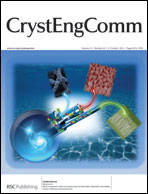Hydrothermal synthesis of needle-like hyperbranched Ni(SO4)0.3(OH)1.4 bundles and their morphology-retentive decompositions to NiO for lithium storage†
Abstract
In this work, nickel basic sulfate (Ni(SO4)0.3(OH)1.4) with a unique morphology of needle-like hyperbranched bundle was fabricated on a large scale via a template-free hydrothermal reaction between nickel acetate and dextran sulfate. The gradual release of OH− from hydrolysis of the acetate plays a key role in the formation of the nanoneedle bundles. With increasing amounts of the dextran sulfate, the hydrothermal precipitates changed from stacked nanoplates to nanoneedle bundles and then to aggregated nanowires. Based on the crystal lattice analysis, a growing mechanism of the various nanostructures is proposed. The nanoneedle bundle architecture can be maintained after a subsequent heat treatment in air at a high temperature of 750 °C, which is significantly higher than the upper limit for most of the reported Ni(SO4)0.3(OH)1.4 to preserve the original nanostructures. Thanks to the extremely high morphology stability, the Ni(SO4)0.3(OH)1.4 nanoneedle bundles can be decomposed thoroughly to NiO nanoneedle bundles with high crystallinity. When utilized as anode materials for Li-ion battery, the NiO nanoneedle bundles presented a very high initial discharge capacity; but just like most NiO nanostructures, the cyclic stability remains to be further improved.


 Please wait while we load your content...
Please wait while we load your content...